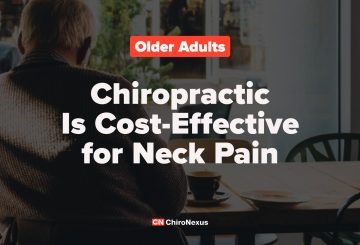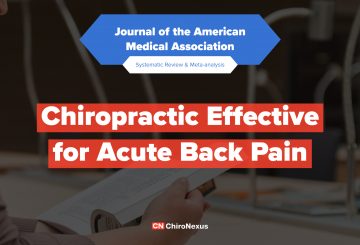-
31 f 2018

“
Although most people dream of being financially secure in their older years, sadly, this isn’t turning out to be the case. In fact, the National Council on Aging reports that more than 25 million of our nation’s 60+ year olds are considered “economically insecure” as they’re living at or below the federal poverty level, which is just under $30k a year. Ultimately, this often means having to decide which bills get paid first, which ones don’t get paid at all, and what things they can go without. Sometimes, looking after their health doesn’t make the cut. Yet, one study has found that chiropractic can be a cost effective treatment option for older adults struggling with the all-too common issue of chronic neck pain. The study was funded by the National Institute of Health and Health Resources and Services Administration and, in it, the researchers set out to determine the cost-effectiveness of three different treatment options: home exercise and advice (HEA), HEA combined with spinal manipulative therapy (SMT), and HEA combined with supervised rehabilitative exercise (SRE). Results were published in the November 2016 edition of The Spine Journal and, among those studied were 241 individuals aged 65 or older in the Minneapolis, Minnesota suffering with chronic mechanical neck pain. To be included, the participants had to be over a “3” on a 0-10 pain scale for three months or more, and the pain had to be accompanied by stiffness or tenderness in the cervical spine. Once accepted, participants were assigned to one of the three treatment groups for a total of 12 weeks. The HEA-only group received four one-hour sessions in which they were instructed as to which exercises would help and how to self-manage the pain. The HEA + SMT group received the same, plus up to 20 sessions with a chiropractor. The HEA + SRE group had the same four instruction sessions, plus 20 one-hour sessions working on neck exercises with an exercise therapist. The costs of the treatments and their effectiveness were followed for one year, with data calculations occurring at the one, three, and six month marks, as well as at the end of the study. Based on the results, researchers determined that SMT and HEA combined “resulted in the greatest reduction of neck pain and disability, and the most gains in QALYs” (quality-adjusted life years). Furthermore, this combined treatment method was five percent lower in cost than HEA alone and 47 percent lower than SRE and HEA combined when taking into account both direct and indirect costs. Thus, chiropractic can be part of an affordable, yet effective treatment plan for this segment of the population. Leininger B, McDonough C, Evans R, Tosteson T, Tosteson AN, Bronfort G. Cost-effectiveness of spinal manipulative therapy, supervised exercise, and home exercise for older adults with chronic neck pain. The Spine Journal 2016;16(11):1292-1304.”Economic Security for Seniors Facts. (n.d.). National Council on Aging.
-
23 f 2018

“
”Statistics compiled by the American Chiropractic Association (ACA) tell us that back pain affects a large majority of the population, with roughly 80 percent of people enduring at least one back-related issue during the course of their lives. In fact, there are currently 31 million people in the U.S. alone dealing with chronic, daily back pain.
With these types of numbers floating around, chiropractic patients may feel as if their back pain is inevitable, making the seeking of treatment futile. However, one recently released study review says otherwise, that is, as long as the treatment plan includes chiropractic.
The Journal of the American Medical Association (JAMA) published a systematic review and meta-analysis conducted by 10 medical professionals from medical centers, universities, and healthcare systems across the U.S. The main question this group set out to answer was, “Is the use of spinal manipulative therapy in the management of acute (≤6 weeks) low back pain associated with improvements in pain or function?”
After taking a more in-depth look at 26 different randomized clinical trials occurring between January of 2011 and February of 2017, all of which involved spinal manipulative therapy (SMT), this set of researchers found that, in 15 of the studies, this particular treatment option provided “statistically significant benefits” for the 1,711 patient subjects when it came to lowering their levels of pain. In this same group of studies, almost half of the cases (12) also found major positive effects in regard to the level of function of the 1,381 participants when compared to sham chiropractic or other treatment methods.
It should also be noted that, while 50 to 67 percent of the participants in these studies reported experiencing headaches, muscle stiffness, or even increased pain after SMT, no serious adverse events occurred. This helps confirm chiropractic’s safety, making it a viable method of treating acute back pain episodes quickly and effectively.
These findings are extremely important as another statistic offered by the ACA is that approximately 50 percent of the working population has struggled with some type of back-pain issue in the previous 12 months. Thus, one very effective way to keep them earning an income and supporting their families in a manner that treats the symptoms and cause of their pain is regular and consistent chiropractic care.
This saves them both time off work and money due to unnecessary (and usually costly) medical bills, enabling them to spend both on the things they enjoy instead.
- American Chiropractic Association. (n.d.) Back Pain Facts and Statistics.
- Paige NM, Miake-Lye IM, Booth MS, Beroes JM, Mardian AS, Dougherty P, Branson R, Tang B, Morton SC, Shekelle PG. Association of Spinal Manipulative Therapy With Clinical Benefit and Harm for Acute Low Back Pain: Systematic Review and Meta-analysis. 2017;317(14);1451-1460. doi:10.1001/jama.2017.3086
